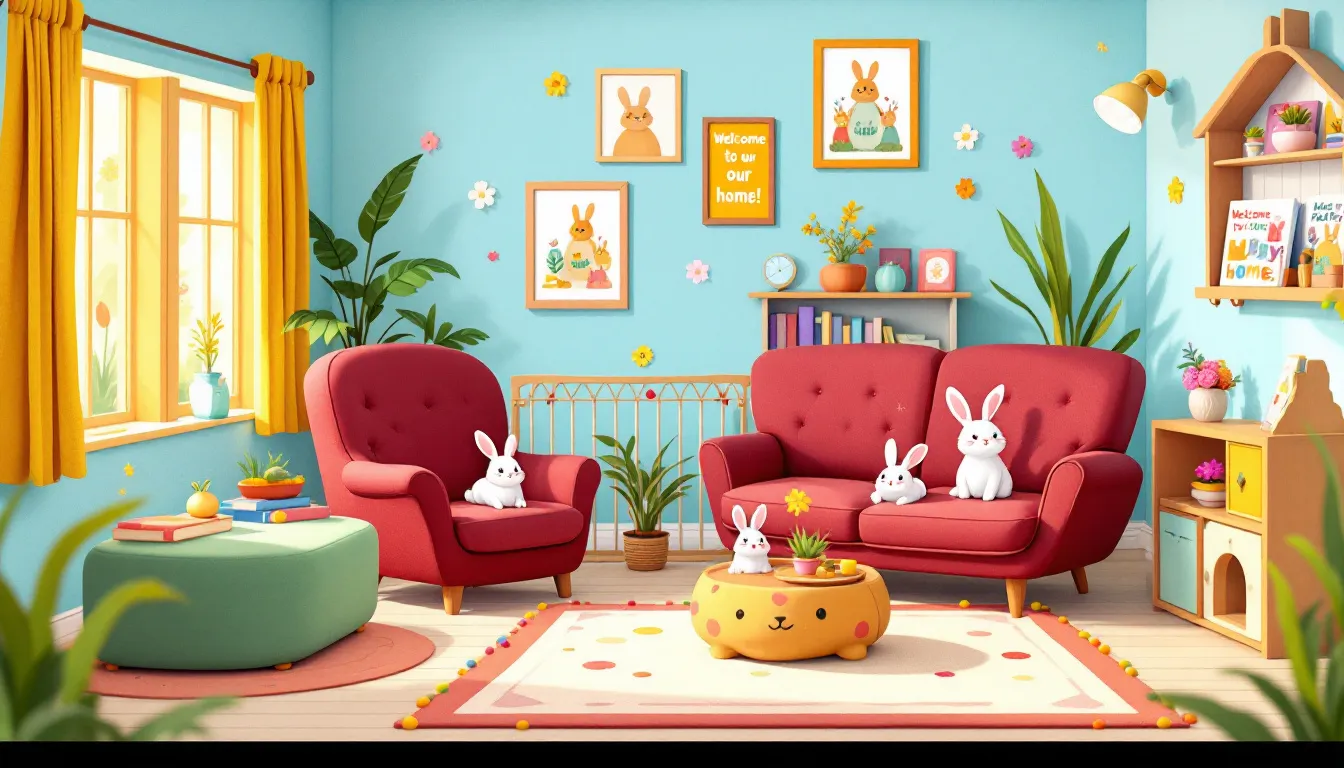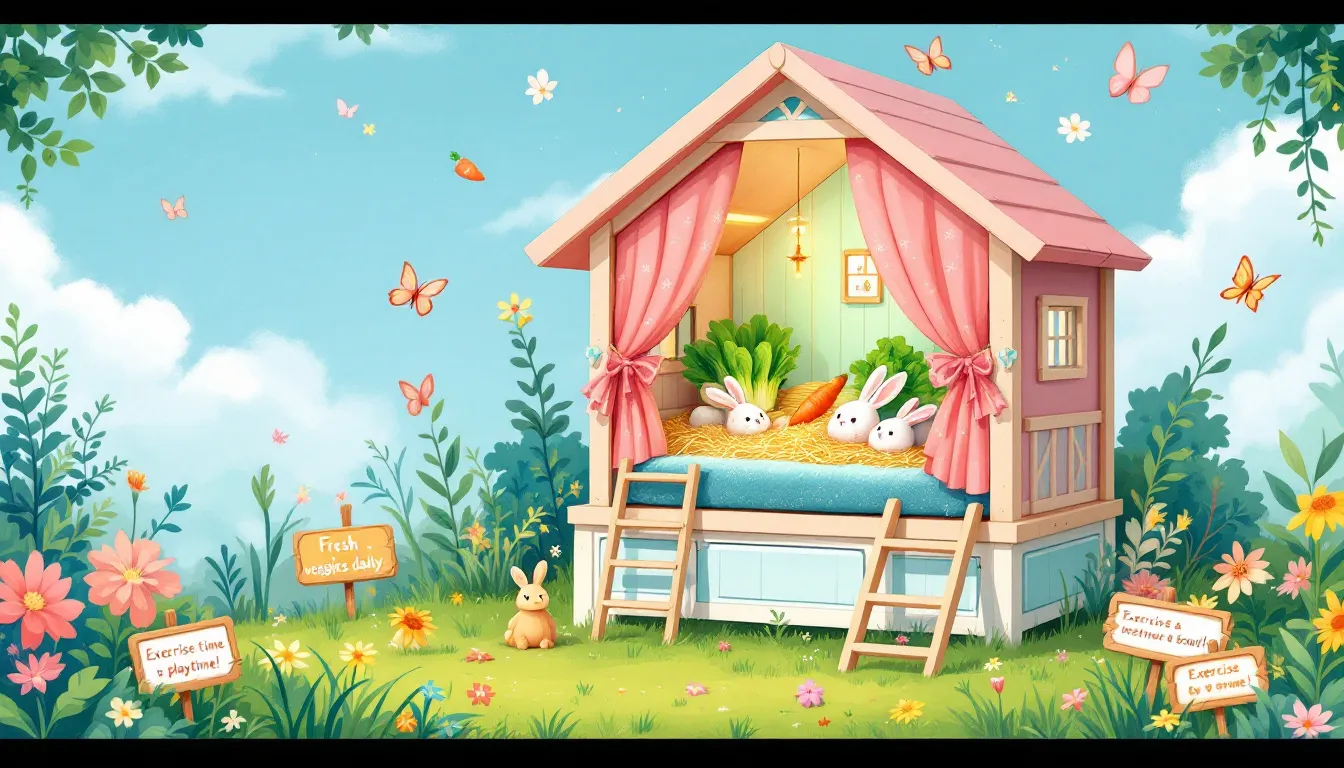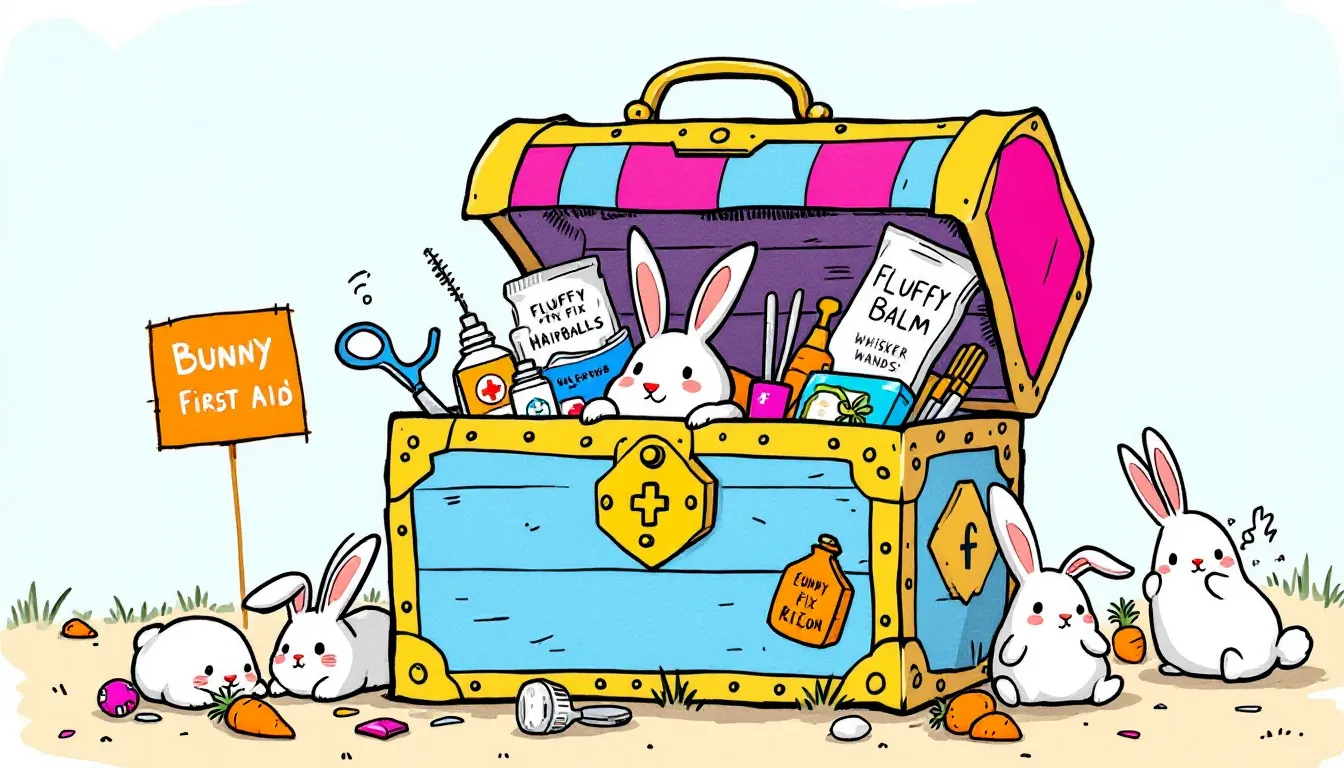Searching for practical solutions to everyday rabbit care? Our top 10 essential rabbit hacks will help you tackle common challenges and ensure your bunny stays happy and healthy.
Key Takeaways
- Rabbit-proof your home by securing cables and using sturdy protectors to keep your curious bunny safe.
- DIY toys are a great way to keep your rabbits engaged and happy while preventing boredom and destructive behavior.
- A balanced diet with unlimited Timothy hay and limited pellets is crucial for your rabbit’s health and happiness.
Rabbit-Proofing Your Home

Rabbit-proofing is essential for the safety and well-being of your pet rabbit. These curious creatures love to explore and chew on anything they can get their teeth on, which can lead to both damage and potential hazards. Start by using a pen to restrict their access to dangerous areas in your home to prevent rabbits from getting into trouble. This allows you to gradually introduce them to new spaces while monitoring their behavior.
Cables and wires are particularly tempting for rabbits, and chewing on them can be dangerous. Secure these items by pinning them out of reach or covering them with durable protectors. Flex tubing can also be used to protect electrical cords from rabbit chewing, adding an extra layer of safety. Applying bitter apple spray or rubbing pure Ivory soap on furniture and baseboards can also deter your bunny from chewing on these surfaces. This simple trick can save your furniture from becoming a rabbit chew toy.
Don’t forget about your floors! Carpets can be protected from digging and chewing by using corner protectors, floor covers, or ceramic tiles in areas where your rabbits may cause damage. Taking a few precautionary measures can create a rabbit-safe environment, ensuring both your home and your bunnies remain secure and happy.
DIY Rabbit Toys

Entertaining your pet rabbits is crucial for their mental and physical health. Providing a variety of DIY toys that encourage natural behaviors and prevent boredom is one of the best ways to do this. Transform simple household items into engaging toys that your rabbits will love. For instance, filling toilet paper rolls with hay creates a fun and interactive chew toy that keeps your bunnies occupied for hours. Additionally, egg cartons can be repurposed as chew and forage toys, offering another layer of enrichment.
Cardboard boxes with holes cut into them offer endless opportunities for play and exploration. You can also use large paper grocery bags as hiding spots, which rabbits find incredibly amusing. Straw or wicker baskets serve a dual purpose as both chew toys and cozy hiding places. These easy-to-make toys not only provide entertainment but also help prevent your rabbits from damaging household items out of boredom.
Offering variety in rabbit toys is key. Wooden clothespins soaked in juice, PVC tubes cut into tunnels, and soft towels or blankets for rearranging all offer different forms of mental stimulation. Regularly rotating these toys and introducing new ones keeps your bunnies engaged and happy, ensuring they have plenty of safe and fun activities.
Efficient Litter Box Training
Litter box training your rabbit can be challenging, but with patience and consistency, it can be done successfully. Limit your rabbit’s living area initially to simplify the training process. This helps them understand where to go potty and reduces accidents around the house.
Place the litter box in a corner where your rabbit naturally tends to eliminate. Adding some of their droppings and urine-soaked bedding to the box can help them recognize it as their designated toilet area. Including fresh hay in or near the litter box can also entice your rabbit to use it, as they often eat while eliminating. This dual-purpose setup encourages good litter box habits while satisfying their natural behaviors.
Maintain consistency during this training period. Clean any accidents with non-scented cleaners to avoid confusing your rabbit. Once they consistently use the litter box, you can gradually expand their living area. With patience and these handy tips, you’ll have a well-trained rabbit in no time.
Creating a Cozy Rabbit Hutch

A cozy and comfortable rabbit hutch is vital for your pet’s well-being. Whether you keep your rabbits indoors or outdoors, their enclosure should provide a safe space for exercise and mental engagement. For indoor habitats, select a quiet area that minimizes stress while allowing for regular interaction. This balance helps your rabbits feel secure and loved.
Outdoor hutches should offer protection from harsh weather and access to grass for a natural exercise environment. Grass is great for rabbits to eat because it’s high in fiber and keeps their teeth healthy. Ensure that each rabbit has at least 1.1 square meters of space to accommodate their natural behaviors. This ample space allows them to hop, stretch, and explore, which are all crucial for their physical health.
Adding cozy bedding, hiding spots, and chew toys can make the hutch even more inviting. Interact with your rabbits regularly to strengthen your bond and keep them mentally stimulated. Creating a comfortable and engaging environment ensures your rabbits have a happy and healthy home.
Feeding Hacks: Maximizing Nutrition
Proper nutrition is essential for good rabbit care. Timothy hay should be provided in unlimited amounts daily, as it promotes proper digestion and prevents health issues. Its high fiber content is particularly beneficial for maintaining a rabbit’s overall health. Avoid feeding adult rabbits alfalfa hay, which is high in calcium and carbohydrates and can lead to health complications. A balanced diet is crucial for maintaining your rabbit’s health and preventing obesity and other serious conditions.
Quality rabbit pellets should be given in limited quantities. Overfeeding pellets can cause obesity and other health problems, so moderation is key. It’s also important to avoid feeding rabbits iceberg lettuce and cabbage, which can cause digestive upsets. Instead, offer a variety of fresh vegetables that are safe for rabbits.
Following these tips ensures your rabbits receive the proper nutrition they need to thrive. A balanced diet keeps them healthy and contributes to their overall happiness and well-being.
Managing Fur and Shedding
Managing your rabbit’s fur and shedding is a vital aspect of their care. During heavy shedding periods, daily grooming prevents loose fur from matting and keeps their coat healthy. Using a lint roller can help remove excess fur from your rabbit, making grooming sessions more effective. Regular grooming sessions also provide an opportunity to bond with your rabbit and check for any signs of health issues.
Vacuuming regularly with a high-suction vacuum can effectively remove fur from carpets and surfaces where your rabbits spend time. Using furniture covers makes it easier to clean fur from upholstery, especially during times of significant shedding.
These steps will help you manage shedding and keep your home clean and fur-free.
Emergency Aid Kit for Rabbits

An emergency aid kit for your pet rabbit is vital for handling minor injuries and common health issues at home. Essential items to include are:
- Syringes for measuring
- Saline solution
- An animal-safe heating pad
- Neosporin without pain relief
- Gauze pads
- Disinfectant solution (a mix of hydrogen peroxide and water)
- Styptic powder or cornstarch for controlling bleeding
- Towels
- Gloves
These items treat minor injuries, control bleeding, maintain hygiene, and provide emergency care.
Keep contact information for a veterinarian readily available in the emergency aid kit. Quick access to professional help can make a significant difference during a health crisis. Being prepared ensures your rabbit receives the best care possible in any situation.
Preventing Destructive Chewing
Destructive chewing is a common challenge for rabbit owners. Offering safe alternatives like cardboard boxes with openings can redirect your rabbit’s chewing behavior away from harmful objects. Providing digging opportunities, such as shallow planters filled with soil, can satisfy their natural instincts and keep them engaged.
Creating forage trays with hidden food can mimic their natural behavior of searching for food and provide mental stimulation. Using tricks with treats to cover foraging ideas can motivate your rabbits to approach and interact more confidently during play.
Understanding your rabbit’s natural behaviors and providing appropriate outlets prevents destructive chewing, keeping them happy and healthy.
Socializing Your Bunny
Socializing your bunny builds a strong and trusting relationship. Start by creating a safe and calm environment to ease their anxiety. Use treats and gentle petting to encourage your bunny to come to you, strengthening your bond. Spending time sitting quietly with your bunny helps them feel secure and builds trust.
Involve family members in the socialization process by allowing them to feed treats to the bunny, fostering positive associations. Engage in playtime using toys to strengthen the bond and create happy experiences with friends together.
Introduce your bunny to other pets gradually, ensuring that interactions are supervised and positive. Following these steps helps your bunny feel more comfortable and confident in your home.
Keeping Your Rabbit Active

Keeping your rabbit active is vital for their physical and mental health. Rabbits should ideally have at least three hours of exercise daily in a secure outdoor run. Boredom can lead to destructive behavior, so providing enrichment is essential. Offering rabbit-safe toys, tunnels, and dig boxes can enhance their playtime and keep them engaged.
Supervised playtime outside of their cage keeps rabbits engaged and less likely to chew on furniture or cords. Interacting with your rabbits at their level builds trust and encourages engagement during playtime. Incorporating different levels in their play area encourages jumping, which is a fun activity for rabbits.
Keeping your rabbits active ensures they remain happy and healthy in their life and buns.
Summary
In summary, ensuring your rabbits are happy and healthy involves a combination of proper housing, nutrition, and mental stimulation. From rabbit-proofing your home to creating engaging DIY toys, these essential hacks provide practical solutions for common challenges in rabbit care. Efficient litter box training, creating a cozy hutch, and managing fur shedding are all crucial aspects of keeping your rabbits comfortable and well-cared for.
By following these tips and incorporating them into your daily routine, you can create a loving and enriching environment for your pet rabbits. Remember, a little effort goes a long way in ensuring your bunnies live a happy and healthy life. So, hop to it and make your rabbits’ well-being a top priority!
Frequently Asked Questions
How can I prevent my rabbit from chewing on wires and furniture?
To stop your rabbit from chewing on wires and furniture, keep them out of reach or cover them with tough protectors. You can also use bitter apple spray or pure Ivory soap to make your furniture less appealing. It’ll save your stuff and keep your bunny safe!
What are some easy DIY toys I can make for my rabbit?
You can easily make toys for your rabbit using things like toilet paper rolls stuffed with hay, cardboard boxes with holes for fun hiding spots, and large paper grocery bags for them to explore. Your rabbit will love these simple creations!
How do I litter-train my rabbit effectively?
To effectively litter-train your rabbit, set up a litter box in a corner they already use and toss in some of their droppings or urine-soaked bedding to help them get the hint. Just be patient, and they’ll catch on quickly!
What should I include in an emergency aid kit for my rabbit?
You definitely want to pack essentials like syringes, saline solution, an animal-safe heating pad, and Neosporin (without pain relief) in your rabbit’s emergency aid kit. Don’t forget towels, gauze, disinfectant, styptic powder or cornstarch, gloves, and your vet’s contact info for quick access!
How can I keep my rabbit active and prevent boredom?
To keep your rabbit active and ward off boredom, give them a secure outdoor run, some fun toys, and tunnels to explore. Regular supervised playtime outside their cage is a must for keeping them engaged, too!



